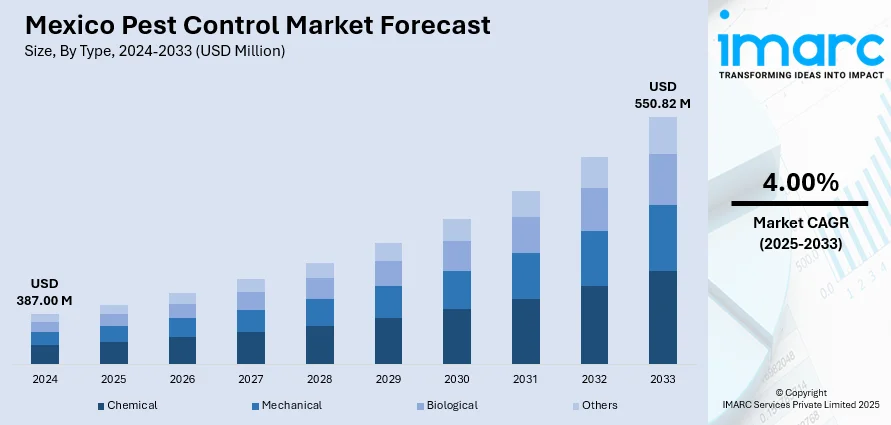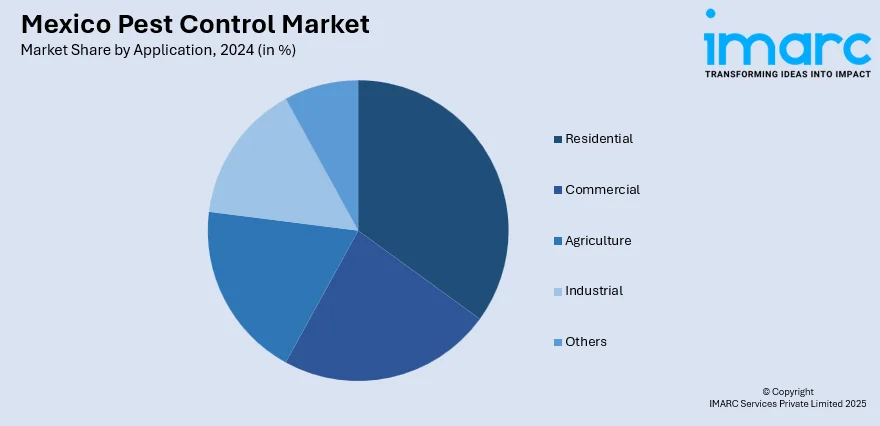
Mexico Pest Control Market Size, Share, Trends and Forecast by Type, Pest Type, Application, and Region, 2025-2033
Mexico Pest Control Market Overview:
The Mexico pest control market size reached USD 387.00 Million in 2024. Looking forward, IMARC Group expects the market to reach USD 550.82 Million by 2033, exhibiting a growth rate (CAGR) of 4.00% during 2025-2033. The market is growing steadily due to rising urbanization, rising awareness about hygiene, and the expansion of the food and hospitality sectors. Advancements in eco-friendly and integrated pest management solutions are also driving product adoption across residential, commercial, and agricultural areas. These trends are contributing to the increased Mexico pest control market share.
|
Report Attribute
|
Key Statistics
|
|---|---|
|
Base Year
|
2024
|
|
Forecast Years
|
2025-2033
|
|
Historical Years
|
2019-2024
|
| Market Size in 2024 | USD 387.00 Million |
| Market Forecast in 2033 | USD 550.82 Million |
| Market Growth Rate 2025-2033 | 4.00% |
Mexico Pest Control Market Trends:
Rising Urbanization and Infrastructure Development
Rapid urbanization in Mexico has led to dense population centers with growing residential and commercial infrastructure. As urban areas expand, the risk of pest infestations increases due to concentrated waste generation, poor sanitation in certain zones, and climate-sensitive structures. Pests like rodents, cockroaches, and termites thrive in such environments, leading to increased demand for effective pest control solutions. In addition, the construction of new buildings often disrupts local ecosystems, pushing pests into populated areas. As cities grow and housing developments increase, pest control services are becoming essential for both preventive and remedial purposes. This urban shift creates consistent market demand, particularly in high-growth regions like Mexico City, Guadalajara, and Monterrey.

Increasing Awareness about Health and Hygiene
There is growing public awareness in Mexico about the health risks associated with pest infestations, including the spread of diseases such as dengue, Zika, leptospirosis, and salmonella. This awareness, amplified by public health campaigns and media coverage, has prompted individuals and institutions to proactively seek pest control services, thus driving the Mexico pest control market growth. Residential areas, schools, hospitals, and office buildings are increasingly investing in regular pest inspections and treatments. Consumers now value pest control not just for comfort but as an essential component of disease prevention. The COVID-19 pandemic further heightened focus on cleanliness and sanitation, accelerating the adoption of integrated pest management (IPM) techniques and eco-friendly pest control products that align with modern health standards.
Government Regulations and Support for Agricultural Pest Management
Mexico's agricultural sector is a vital part of its economy, and the government has implemented regulations and programs aimed at improving crop yields and protecting exports from pest-related damage. Government-supported initiatives for pest surveillance, biosecurity, and integrated pest management (IPM) are boosting demand for specialized pest control services in rural and farming communities. Compliance with international phytosanitary standards is especially important for exporters, and pest control is essential to maintaining product quality and certification. Furthermore, environmental regulations have encouraged the adoption of more sustainable and less toxic pest control methods, opening the market for innovative solutions and eco-friendly products. These combined factors drive both agricultural and regulatory-based demand across the country. For instance, in November 2024, the United States and Mexico reaffirmed their commitment to cooperating to stop the screwworm from entering Mexican territory and to take prompt action to control and eradicate it if it is found. This program aims to maintain bilateral trade while safeguarding cattle production. This initiative reflects bilateral governmental action to control and eradicate pests that threaten livestock and agricultural productivity.
Mexico Pest Control Market Segmentation:
IMARC Group provides an analysis of the key trends in each segment of the market, along with forecasts at the country and regional levels for 2025-2033. Our report has categorized the market based on type, pest type, and application.
Type Insights:
- Chemical
- Mechanical
- Biological
- Others
The report has provided a detailed breakup and analysis of the market based on the type. This includes chemical, mechanical, biological, and others.
Pest Type Insights:
- Insects
- Termites
- Rodents
- Others
A detailed breakup and analysis of the market based on the pest type have also been provided in the report. This includes insects, termites, rodents, and others.
Application Insights:

- Residential
- Commercial
- Agriculture
- Industrial
- Others
A detailed breakup and analysis of the market based on the application have also been provided in the report. This includes residential, commercial, agriculture, industrial, and others
Regional Insights:
- Northern Mexico
- Central Mexico
- Southern Mexico
- Others
The report has also provided a comprehensive analysis of all the major regional markets, which include Northern Mexico, Central Mexico, Southern Mexico, and others.
Competitive Landscape:
The market research report has also provided a comprehensive analysis of the competitive landscape. Competitive analysis such as market structure, key player positioning, top winning strategies, competitive dashboard, and company evaluation quadrant has been covered in the report. Also, detailed profiles of all major companies have been provided.
Mexico Pest Control Market Report Coverage:
| Report Features | Details |
|---|---|
| Base Year of the Analysis | 2024 |
| Historical Period | 2019-2024 |
| Forecast Period | 2025-2033 |
| Units | Million USD |
| Scope of the Report |
Exploration of Historical Trends and Market Outlook, Industry Catalysts and Challenges, Segment-Wise Historical and Future Market Assessment:
|
| Types Covered | Chemical, Mechanical, Biological, Others |
| Pest Types Covered | Insects, Termites, Rodents, Others |
| Applications Covered | Residential, Commercial, Agriculture, Industrial, Others |
| Regions Covered | Northern Mexico, Central Mexico, Southern Mexico, Others |
| Customization Scope | 10% Free Customization |
| Post-Sale Analyst Support | 10-12 Weeks |
| Delivery Format | PDF and Excel through Email (We can also provide the editable version of the report in PPT/Word format on special request) |
Key Questions Answered in This Report:
- How has the Mexico pest control market performed so far and how will it perform in the coming years?
- What is the breakup of the Mexico pest control market on the basis of type?
- What is the breakup of the Mexico pest control market on the basis of pest type?
- What is the breakup of the Mexico pest control market on the basis of application?
- What is the breakup of the Mexico pest control market on the basis of region?
- What are the various stages in the value chain of the Mexico pest control market?
- What are the key driving factors and challenges in the Mexico pest control?
- What is the structure of the Mexico pest control market and who are the key players?
- What is the degree of competition in the Mexico pest control market?
Key Benefits for Stakeholders:
- IMARC’s industry report offers a comprehensive quantitative analysis of various market segments, historical and current market trends, market forecasts, and dynamics of the Mexico pest control market from 2019-2033.
- The research report provides the latest information on the market drivers, challenges, and opportunities in the Mexico pest control market.
- Porter's five forces analysis assist stakeholders in assessing the impact of new entrants, competitive rivalry, supplier power, buyer power, and the threat of substitution. It helps stakeholders to analyze the level of competition within the Mexico pest control industry and its attractiveness.
- Competitive landscape allows stakeholders to understand their competitive environment and provides an insight into the current positions of key players in the market.
Need more help?
- Speak to our experienced analysts for insights on the current market scenarios.
- Include additional segments and countries to customize the report as per your requirement.
- Gain an unparalleled competitive advantage in your domain by understanding how to utilize the report and positively impacting your operations and revenue.
- For further assistance, please connect with our analysts.
 Request Customization
Request Customization
 Speak to an Analyst
Speak to an Analyst
 Request Brochure
Request Brochure
 Inquire Before Buying
Inquire Before Buying




.webp)




.webp)












